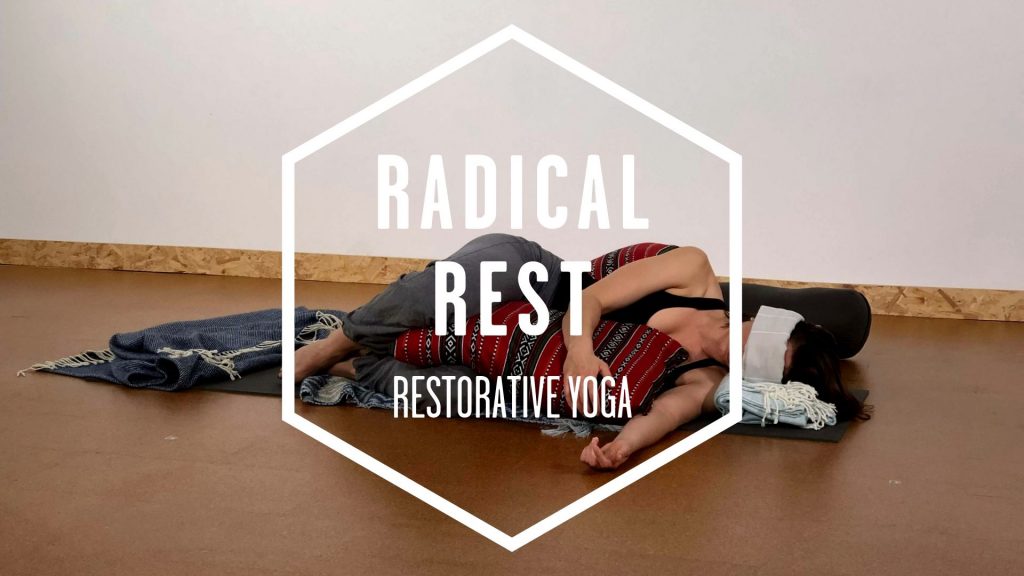
What is the most advanced yoga you have practiced this week? Did it involve radical rest? Kat Farrants gets to grip with some advanced yoga and confronts some demons in the process.
In our culture we have a ‘work hard, play hard’ ethic. We are told to be more productive and more efficient, to set goals, to work night and day to achieve, to dare to dream. We are told to ‘work’ on ourselves. And the thing is, I have internalised that message. I know it is consumerism gone mad. This is just the crazy result of industrialisation and a culture that wants us to feel we are never enough so that we can buy more. But I really have internalised it and it’s incredibly hard for me to find rest. Forget about radical rest!
Rest as health elixir
I was absolutely terrible at rest for my first 20 years of yoga. I would walk out of savasana. Why on earth waste time lying down when there are things that we need to do? As I have aged and mellowed, and as yoga has very gently but persistently worked it’s magic on me, I’ve started to realise how very radical this act of lying down at peace can be.
I’ve heard Henrietta Norton, the nutritionist saying that when we’re in a state of stress, we can’t absorb the nutrition we’re taking in. Did you know that it doesn’t matter how healthily you eat, if you don’t get to rest, you can’t absorb the nutrients? And without rest we can suffer from disease caused by inflammation.
I’m hearing the radical women at the Red School saying that the inability to rest is what stops many women from becoming pregnant, experiencing PMT and period pain. (I’ve recorded a podcast on this topic, we’ll release it soon) In my podcast with her, Mimi Kuo-Deemer, describes how in Ancient China the menopause was a positive time: a ‘second spring’. This of course, is the experience of women who have taken the time to rest and prepare the land for the spring.
As Adrianna describes in her podcast this week, in nature there is winter. There is no spring, no vitality and renewed energy, without the winter of letting go and lying fallow.
An internal practice
The ‘yoga industry’ has been part of a fairly vicious self-improvement mission. People are relentlessly doing workouts, performing shapes and developing a ‘yoga body’. Self-improvement seems to have been all about buying a never-ending stream of devices, fancy outfits, books, gadgets and DVD’s to help us to be our best selves. But the thing that is missing even in much of the yoga world is an actual coming into yoga; a union with ourselves. In this culture, we value surface looks and the shapes of an ‘advanced’ yoga practice often appear on instagram. There is nothing much to look at with restorative yoga. Just somebody deeply resting and feeling better inside themselves.
Radical Rest: Radical Self-Acceptance
But if there’s one message that I’d love to change in the world; it’s that of radical self-acceptance. The ability to be at peace with ourselves, rest quietly and feel all that we are in the world. I find meditation is an ‘easier’ practice because there is still a lot of doing, than restorative yoga which I practice in silence and in rest. Of focusing on the breath, tethering the mind to a focus – of sitting in a certain position. This gives the mind and the body a distraction, something to do. Similarly, I really love yoga nidra, as this focused relaxation also gives the mind a job. The job of relaxing.
Adrianna offers something even more radical than this. Her classes include very few poses, really just variations on savasana. The idea is that, in order for the body to get into a place of compete restoration, the body should feel no sensations at all. It’s very tempting for me to want to shortchange on the bolsters, blocks and props which cushion us and really increase the comfort. Whereas in a yin yoga practice we feel the sensations, often very strongly, and learn to stay with them, in restorative yoga, we learn to go inwards, feeling nothing.
Be Radical
This is such a radical practice on so many levels as in our culture resting is the same as lazy. How often do we hear that that taking a nap in the afternoon is lazy and that the ‘early bird gets the worm’. In our culture, the land is almost unusable due to our concern with production over values; our bodies aren’t able to digest food; anxiety and overwhelm prevail. We need to reimagine what we mean when we talk about the ‘survival of the fittest.’ The fittest are the nurtured and the rested. They will be the most creative and get the most out of our short time on this earth, without getting struck by the immunity and fatigue illnesses which we find everywhere around us. As Tara Brach puts it, it is ‘Survival of the Nurtured’.
I do hope you enjoy Adrianna’s podcast as much as I do. And do try her very challenging practices, only for the most advanced practitioners!

About Kat Farrants:

Movement for Modern Life’s fabulous founder Kat Farrants lives her yoga and her own yoga practice informs how she develops MFML. Kat wrote this post using inspiration of how she can take the small steps to move into a happier, healthier and more sustainable life. Please do join her on this journey and explore with us your happiest, healthiest, most sustainable life.





Leave a Reply